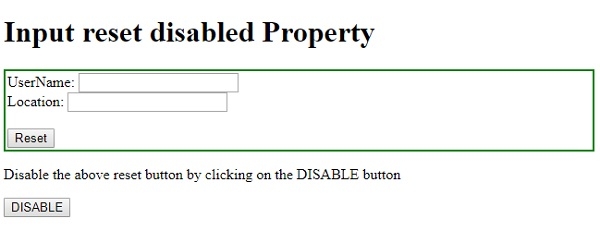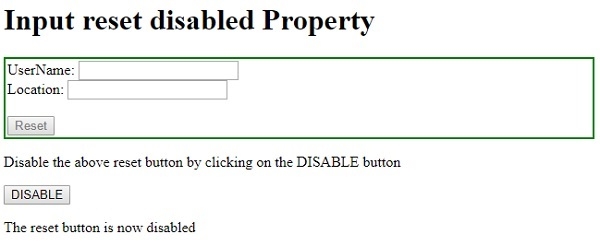 Web Front-end
Web Front-end
 HTML Tutorial
HTML Tutorial
 HTML DOM Input Reset disabled attribute
HTML DOM Input Reset disabled attribute is used to set or get whether the reset button is disabled
HTML DOM Input Reset disabled attribute
HTML DOM Input Reset disabled attribute is used to set or get whether the reset button is disabled
HTML DOM Input Reset disabled attribute HTML DOM Input Reset disabled attribute is used to set or get whether the reset button is disabled
HTML DOM Input reset disabled attribute is used to set or return whether the reset button should be disabled. It uses a boolean value, where true means the reset button should be disabled and false means no. The disabled attribute defaults to false. disabled elements are gray and unclickable by default.
Syntax
The following is the syntax of −
Set the disabled attribute−
resetObject.autofocus = true|false
Here, true=reset button is disabled and false=the reset button is not disabled. It is false by default.
Example
Let us look at an example for the Input reset disabled property −
Live Demo
<!DOCTYPE html>
<html>
<body>
<h1>Input reset disabled Property</h1>
<form style="border:solid 2px green;padding:2px">
UserName: <input type="text" id="USR"> <br>
Location: <input type="text" id="Age"> <br><br>
<input type="reset" id="RESET1">
</form>
<p>Disable the above reset button by clicking on the DISABLE button</p>
<button type="button" onclick="disableReset()">DISABLE</button>
<p id="Sample"></p>
<script>
function disableReset() {
document.getElementById("RESET1").disabled=true;
document.getElementById("Sample").innerHTML = "The reset button is now disabled" ;
}
</script>
</body>
</html>Output
This will produce the following output −

Click on the “DISABLE” button −

in In the above example −
we created an element with type="reset" and id="RESET1". Clicking this button will reset the form data. This button is in a form with two text fields that also has inline styles applied −
<form style="border:solid 2px green;padding:2px"> UserName: <input type="text" id="USR"> <br> Location: <input type="text" id="Age"> <br><br> <input type="reset" id="RESET1"> </form>
Then we create a button called DISABLE which will execute the disableReset() method when clicked by the user −
<button type="button" onclick="disableReset()">DISABLE</button>
disableReset() method uses the getElementById() method to obtain the input element of type reset and set its disabled attribute to true. This makes the reset button unclickable and the user can no longer interact with it. It is now gray −
function disableReset() {
document.getElementById("RESET1").disabled=true;
document.getElementById("Sample").innerHTML = "The reset button is now disabled" ;
}The above is the detailed content of HTML DOM Input Reset disabled attribute HTML DOM Input Reset disabled attribute is used to set or get whether the reset button is disabled. For more information, please follow other related articles on the PHP Chinese website!

Hot AI Tools

Undresser.AI Undress
AI-powered app for creating realistic nude photos

AI Clothes Remover
Online AI tool for removing clothes from photos.

Undress AI Tool
Undress images for free

Clothoff.io
AI clothes remover

Video Face Swap
Swap faces in any video effortlessly with our completely free AI face swap tool!

Hot Article

Hot Tools

Notepad++7.3.1
Easy-to-use and free code editor

SublimeText3 Chinese version
Chinese version, very easy to use

Zend Studio 13.0.1
Powerful PHP integrated development environment

Dreamweaver CS6
Visual web development tools

SublimeText3 Mac version
God-level code editing software (SublimeText3)

Hot Topics
 1666
1666
 14
14
 1425
1425
 52
52
 1327
1327
 25
25
 1273
1273
 29
29
 1252
1252
 24
24
 Understanding HTML, CSS, and JavaScript: A Beginner's Guide
Apr 12, 2025 am 12:02 AM
Understanding HTML, CSS, and JavaScript: A Beginner's Guide
Apr 12, 2025 am 12:02 AM
WebdevelopmentreliesonHTML,CSS,andJavaScript:1)HTMLstructurescontent,2)CSSstylesit,and3)JavaScriptaddsinteractivity,formingthebasisofmodernwebexperiences.
 HTML: The Structure, CSS: The Style, JavaScript: The Behavior
Apr 18, 2025 am 12:09 AM
HTML: The Structure, CSS: The Style, JavaScript: The Behavior
Apr 18, 2025 am 12:09 AM
The roles of HTML, CSS and JavaScript in web development are: 1. HTML defines the web page structure, 2. CSS controls the web page style, and 3. JavaScript adds dynamic behavior. Together, they build the framework, aesthetics and interactivity of modern websites.
 The Future of HTML, CSS, and JavaScript: Web Development Trends
Apr 19, 2025 am 12:02 AM
The Future of HTML, CSS, and JavaScript: Web Development Trends
Apr 19, 2025 am 12:02 AM
The future trends of HTML are semantics and web components, the future trends of CSS are CSS-in-JS and CSSHoudini, and the future trends of JavaScript are WebAssembly and Serverless. 1. HTML semantics improve accessibility and SEO effects, and Web components improve development efficiency, but attention should be paid to browser compatibility. 2. CSS-in-JS enhances style management flexibility but may increase file size. CSSHoudini allows direct operation of CSS rendering. 3.WebAssembly optimizes browser application performance but has a steep learning curve, and Serverless simplifies development but requires optimization of cold start problems.
 The Future of HTML: Evolution and Trends in Web Design
Apr 17, 2025 am 12:12 AM
The Future of HTML: Evolution and Trends in Web Design
Apr 17, 2025 am 12:12 AM
The future of HTML is full of infinite possibilities. 1) New features and standards will include more semantic tags and the popularity of WebComponents. 2) The web design trend will continue to develop towards responsive and accessible design. 3) Performance optimization will improve the user experience through responsive image loading and lazy loading technologies.
 HTML vs. CSS vs. JavaScript: A Comparative Overview
Apr 16, 2025 am 12:04 AM
HTML vs. CSS vs. JavaScript: A Comparative Overview
Apr 16, 2025 am 12:04 AM
The roles of HTML, CSS and JavaScript in web development are: HTML is responsible for content structure, CSS is responsible for style, and JavaScript is responsible for dynamic behavior. 1. HTML defines the web page structure and content through tags to ensure semantics. 2. CSS controls the web page style through selectors and attributes to make it beautiful and easy to read. 3. JavaScript controls web page behavior through scripts to achieve dynamic and interactive functions.
 HTML: Building the Structure of Web Pages
Apr 14, 2025 am 12:14 AM
HTML: Building the Structure of Web Pages
Apr 14, 2025 am 12:14 AM
HTML is the cornerstone of building web page structure. 1. HTML defines the content structure and semantics, and uses, etc. tags. 2. Provide semantic markers, such as, etc., to improve SEO effect. 3. To realize user interaction through tags, pay attention to form verification. 4. Use advanced elements such as, combined with JavaScript to achieve dynamic effects. 5. Common errors include unclosed labels and unquoted attribute values, and verification tools are required. 6. Optimization strategies include reducing HTTP requests, compressing HTML, using semantic tags, etc.
 HTML vs. CSS and JavaScript: Comparing Web Technologies
Apr 23, 2025 am 12:05 AM
HTML vs. CSS and JavaScript: Comparing Web Technologies
Apr 23, 2025 am 12:05 AM
HTML, CSS and JavaScript are the core technologies for building modern web pages: 1. HTML defines the web page structure, 2. CSS is responsible for the appearance of the web page, 3. JavaScript provides web page dynamics and interactivity, and they work together to create a website with a good user experience.
 HTML: Is It a Programming Language or Something Else?
Apr 15, 2025 am 12:13 AM
HTML: Is It a Programming Language or Something Else?
Apr 15, 2025 am 12:13 AM
HTMLisnotaprogramminglanguage;itisamarkuplanguage.1)HTMLstructuresandformatswebcontentusingtags.2)ItworkswithCSSforstylingandJavaScriptforinteractivity,enhancingwebdevelopment.



